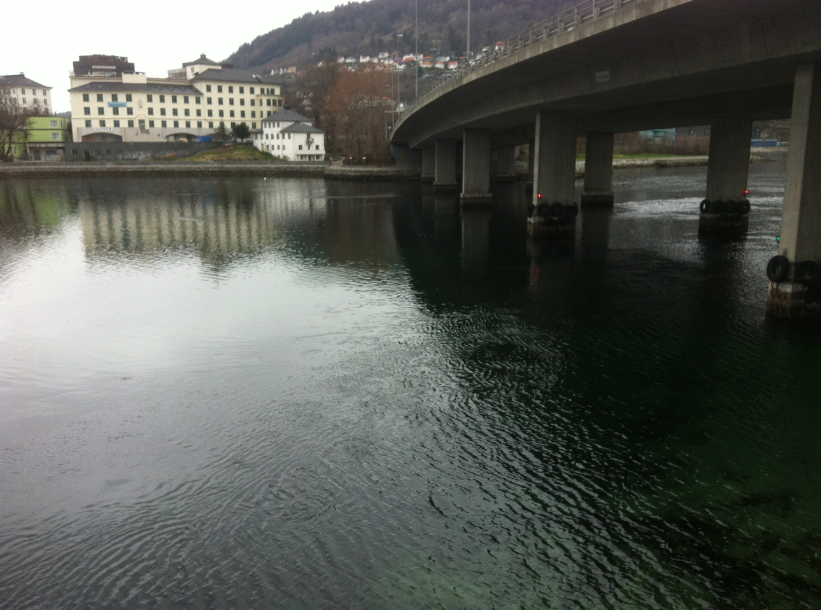
Wind waves meet current
Wind waves on one side of the current – no waves on the other.
Recently in Bergen, I was walking to meet up with a friend at the kayak club, and I had to cross a bridge that has always fascinated me. Underneath the bridge, there is only a very narrow opening connecting basically the ocean on one side and a small bay on the other side. On this part of the Norwegian coast, the tidal range is easily of the order of a meter, so this narrow opening under the bridge makes for some pretty strong currents. In fact, when paddling through that opening, when the tide is right you can really see how the surface elevation changes from one side of the bridge to the other.
So when I was walking there recently, this is what I saw:

Strong current from the lower left to the upper right of the picture, wind blowing from the right, hence waves on the right side of the current and no waves on the left side.
This might be difficult to see on this picture, but there is a strong current going from the lower left corner of the picture towards the upper right. And on the right side of that current there are a lot of wind waves. But on the left side there are hardly any, even though there is nothing blocking the wind, just the current blocking the propagation of waves. Wind is coming from the right here.
I found it really fascinating how this current acted as a barrier to the waves and stood a couple of minutes watching. A couple of people stopped and looked, too, but didn’t find anything interesting to see and were slightly puzzled. But what I see is fetch (or that there isn’t enough of it on the left side of the current) and hydraulic jumps (or that the current is clearly going faster than the waves are). Which means that I start wondering how fast that current would have to be in order to stop waves from propagating across. Which then means I start estimating the wave lengths in oder to estimate the waves’ velocities to answer the previous question. So that’s reason enough to stand there for quite some time, just watching, right?
#BergenWaveWatching: observing waves and tides on Storelungeren - Adventures in Oceanography and Teaching says:
[…] The current acts as a barrier to wind-generated waves. How cool is that? Blog post on this here. […]
#BergenWaveWatching: observing waves and tides on Storelungeren – Elin Darelius & Team says:
[…] The current acts as a barrier to wind-generated waves. How cool is that? Blog post on this here. […]
#BergenWaveWatching: observing waves and tides on Storelungeren – Elin Darelius & team's scientific adventures says:
[…] The current acts as a barrier to wind-generated waves. How cool is that? Blog post on this here. […]
Pengcheng says:
Interesting! Do you mean the current on the left side is faster than that on the right side, so that the effective wind speed is very small?
Mirjam says:
Thanks for commenting! What I meant (but I see that this is totally not coming across from what I wrote :-)) is that the waves are coming in from the far right, passing underneath the bridge. On the other side of that bridge there is a large open space, so plenty of area for the wind to create waves on. By the time the waves pass underneath the bridge, they’ve had quite some time to grow. They propagate towards the lower left of the picture, where they meet a current. The current is fast enough to “sweep” the waves away with it, so they can’t propagate across the current. On the other side of the current, waves only develop slowly from local interaction with the wind, because (a) the fetch is not very large (they now have to start from scratch on the lee side of the current) and (b) that area is relatively sheltered from the wind by the bridge and shape of the coastline. Does this make sense?
Pengcheng says:
I see… Currents and waves are travelling in opposite directions. Thanks for.your detailed explanation!